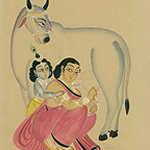
Art history/ Historiography, Crafts, Handlooms, Art, Craftspersons/ Artisanal, Interviews, Conversations
Kalam Patua: Carrying on the Kalighat Tradition
Majumdar, Minhazz
October, 2008
An ancient one and the artists who create them are known as Patua. This tradition features long vertical multi paneled scrolls known as patas (paintings) or jorana patas (rolled paintings) since the scrolls are rolled up for storage and transportation. Each panel represents a particular sequence in the story and as they are unrolled for viewing, the accompanying couplet or story is recited. Painted on sheets of paper glued at the edges to form one continuous roll, these scrolls are mounted on cloth (usually old saris) for greater strength and flexibility. Traditionally, the performer would carry these scrolls from door to door, and depending on people’s request, particular stories would be narrated for a small fee, either in cash or kind.
In 1983, at the age of 21, Kalam held the first show of his works. Soon, Kalam achieved great renown for his finely detailed works, exhibiting his patachitrapaintings at the West Bengal Pavilion, India International Trade Fair, Delhi in 1987, 1988 and 1989. His scrolls on the French Revolution done for the French Cultural Centre in Kolkata were hailed as a new innovation in patachitra art and he collaborated on shows with artists from other countries.
Once he mastered patachitra painting, Kalam focused his attention on yet another Bengali art tradition, namely Kalighat paintings. At first, he was inspired by the paintings of yore and then later developing his own individual repertoire of contemporary Kalighat paintings. Kalighat paintings are believed to have originated in the nineteenth century with the establishment of the Kali ...
This is a preview. To access all the essays on the Global InCH Journal a modest subscription cost is being levied to cover costs of hosting, editing, peer reviewing etc. To subscribe, Click Here.



